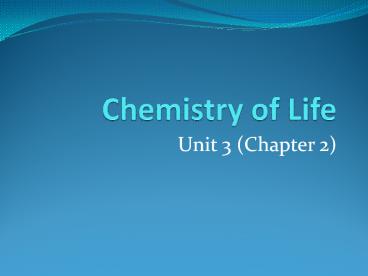Chemistry of Life - PowerPoint PPT Presentation
1 / 42
Title:
Chemistry of Life
Description:
Protons positive in nucleus. Neutrons no charge in nucleus ... Lactase. Lipase. Activation energy. The energy needed to start a chemical reaction ... – PowerPoint PPT presentation
Number of Views:75
Avg rating:3.0/5.0
Title: Chemistry of Life
1
Chemistry of Life
- Unit 3 (Chapter 2)
2
Atoms
- Smallest unit of matter that cannot be broken
down by chemical means - Made of
- Protons positive in nucleus
- Electrons negative in a cloud around nucleus
- Neutrons no charge in nucleus
3
Atoms
4
Element
- Pure substance made of only one kind of atom
- C, N, H, O most common in living organisms
- Periodic table LOTS of info
5
Periodic Table
6
Compound
- Substance made of the joined atoms of two or more
different elements - Example Sodium Chloride (NaCl)
7
UNDERSTANDING CHECK
8
Mixture
- Combination of 2 or more compounds that can be
separated by physical means - Trail mix
- Air
9
Chemical Bonds
- Covalent Bonds when 2 or more atoms SHARE
electrons to form a molecule - Example H2O
10
Chemical Bonds
- Ionic Bonds forms between ions of opposite
charge - Ion charged particle ( or ) from the loss or
gain of electron(s) - Example NaCl Na Cl-
- Animation
11
Chemical Bonds
12
Water Why so important?
- Changes temperature slowly
- Polar molecule
- Positive ears
- Negative chin
- Connects to other water molecules by hydrogen
bonds - animation
13
Water Why so important?
- Cohesion attraction between substances of the
same kind - Surface tension of water
- Adhesion attraction between different polar
substances - Paper towel cleaning up water
14
UNDERSTANDING CHECK
15
Why is water so special?
- 4 reasons that water is so special
- Which is denser ice or liquid water?
- So what happens to ice when you put it in liquid
water? - How can aquatic organisms survive in a frozen
lake?
16
Solution
- Mixture in which one or more substances is evenly
distributed in another substance - Water is the universal solvent
- BUT non-polar molecules do not dissolve well in
water - Example oil water
17
Acids Bases
- Acids form H when dissolved in water
- Example stomach acid
- Bases lower concentration of H when dissolved
in water - Example TUMS (antacid)
- Many bases form OH- in water
18
The pH scale
- Based on the concentration of H in a solution
- Each number represents a factor of 10 on the
scale.
19
UNDERSTANDING CHECK
20
Chemistry of Cells
- Organic Compounds
21
Macromolecules
- Macro large
- Cells make a variety of macromolecules from a
small set of MONOMERS - Like bricks to make buildings
22
Carbohydrates
- Made of carbon, hydrogen, oxygen
- CHO 121
- Function Key source of energy
23
Types of Carbohydrates
- Monosaccharides
- Glucose fructose
- Disaccharides
- Sucrose lactose
- Polysaccharides
- Starch glycogen
- Cellulose
24
Lipids
- Characteristics
- Non-polar
- insoluble in water
- Types of lipids
- Fats
- Phospholipids part of cell membrane
- Steroids including cholesterol
- Waxes pigments
25
Lipids - Fats
- Function store energy
- Structure 3 fatty acids attached to glycerol
- Saturated vs. Unsaturated
- solid liquid
26
UNDERSTANDING CHECK
27
Proteins
- Made of amino acids
- Essential vs. nonessential AA
- LOTS of different types/functions
- Enzymes
- Structural
- In your blood
28
Proteins
- Function is determined by its SHAPE
- Conformation (3D shape) is determined by the
sequence of amino acids
29
Nucleic Acids
- Long chain of nucleotides
- RNA
- DNA
30
ATP
- Adenosine Triphosphate
- Energy storing molecule
P
P
P
ADENOSINE
31
(No Transcript)
32
Major Points
- Make half your grains whole.
- Vary your veggies.
- Focus on fruits.
- Get your calcium-rich foods.
- Go lean with protein.
- Physical activity.
33
Energy
- Ability to move or change matter
- Can be converted between different forms light,
heat, electrical, etc. - Chemical reaction stores or releases energy by
breaking or forming bonds - Reactants ? products
- NaCl ? Na Cl-
34
Energy in Chemical Reactions
35
Enzymes
- Substances that increase the speed of a chemical
reaction - Most are proteins end in ase
- Lactase
- Lipase
36
Activation energy
- The energy needed to start a chemical reaction
- Catalyst substances that reduce the activation
energy of a reaction - Enzymes are one kind of catalyst and control the
rate of metabolic reactions in living cells
37
Activation Energy
38
UNDERSTANDING CHECK
39
How do enzymes work?
- Substrate molecule that an enzyme binds to
- Active site part of the enzyme that binds to
the substrate - Sothe substrate binds to the active site of an
enzyme - Based on SHAPE (they are proteins)
40
How do enzymes work?
- Lowering activation energy
- Pull 2 molecules together
- Push 2 parts of a molecule apart
41
Factors in Enzyme Activity
- Anything that changes the shape of an enzyme
- Temperature
- pH
- Different cells contain different enzymes
therefore have different functions.
42
UNDERSTANDING CHECK































